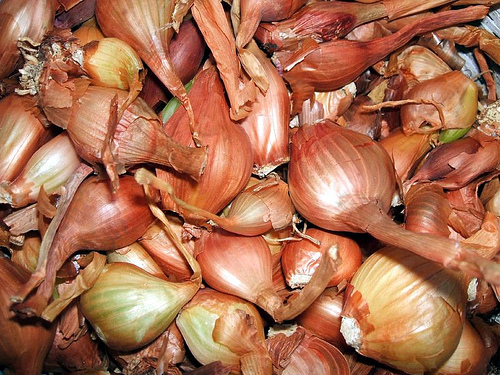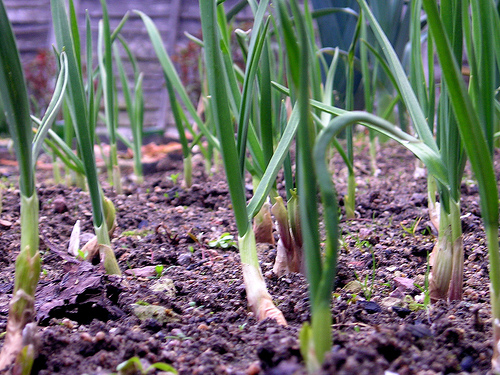Shallots

Gardening Question from Dee:
I emaied you about shallots before.I washed them after I pulled them up but it seems like some of the skins came off.What is the best way to wash without pulling off skins? I planted them in spring( sets)some of them grew but others didn’t.I live in Southern Mississippi zone 9.I was under the understanding you could grow them in spring also.Help!

Photo by AndrewDavison
Answer from Pat:
In cold winter climates shallots should be planted in spring. In mild climates, plant shallots in fall. In Southern Mississipi, USDA Zone 9, I would suppose that your winter is mild enough that you should have planted shallots in fall to allow them a longer growing season. Try this next time. If you plant garlic and short-day onions in fall that is also when you should plant shallots. Shallots are a cool-season crop and need a long growing season. Fall planting allows them longer vegetative growth and that results in larger bulbs when the bulbs finally expand in spring. For example, here in Southern California where I live shallots often grow much bigger than they do in France. Also when you plant in fall, there will be time for them to go dry in the ground at the end of the growing season in late May and June. Then the skins won’t wash off if you need to rinse them off prior to storage. But if you grow them as I have described you may find that washing prior to storage is unnecessary.
Plant shallots from sets (small individual bulbs). Plant 8-inches apart in rows 12-inches apart. Since shallots make a clump, they need more space than garlic. Shallots need well-drained soil, amended with aged manure (not wood products) and organic fertilizers. Heavy soil can be a problem. Don’t use mulch since mulch may rot them. Plant just deep enough so the tip of the bulb is level with the ground. Shallots need approximately one inch of rainfall or irrigation per week to form bulbs.
From your question it sounds as if you harvested shallots before they were ready. For example, in the north of France, where shallots are planted in spring and the climate has rainfall year round, gardeners harvest shallots in July and August. Usually they just pull enough needed for a meal and leave the rest in the ground to continue growing until the tops go brown in fall. Then they pull the rest and store them for winter use.
Next time, as I already explained, you can start harvesting for immediate use when the bulbs are big enough, but if you want to store the bulbs, wait until the tops go brown before harvesting. When your garlic and fall-planted onions are ready to harvest that should be the right time to harvest shallots also, but be sure to stop watering them for a week or two first so the soil dries out, the tops go brown and the bulbs go dormant. Then pull them up, brush off the earth, and dry them dry them on newspaper in a cool dry place such as the garage. When the outer skin is totally dry, it’s safe to wash them off if you feel you must do so. But don’t let them sit in a bucket of water, just rinse them quickly and then once again let them dry on newspaper in the garage as I’ve already explained. Or you can wait and wash them prior to cooking. Your question is interesting since a more frequent problem with shallots is the long time it takes to clean the bulbs and get the papery skin off before cooking.
For more details about storing shallots, please follow this link to refer to what I’ve already written on this subject. https://patwelsh.com/wpmu/blog/vegetables/when-to-harvest-shallots/


I meant to tell you that the reason I pulled up the shallots the tops were dead.I thought that is when you pull them up.You live and learn. God Bless
Sounds as if you pulled them at the right time, Dee. Chances are you’re doing everything correctly.
I live in Los Angeles (Glendora). I planted my garlic and shallots in the spring last year, but they were mushy in the fall. What did I do wrong? Are they supposed to split? These didn’t.
Thank you.
Garlic and shallots should always be planted in fall here then fertilized often to make them grow lots of leaves during winter. In spring they begin to grow a larger bulb and shallots grow several. Harvest in June after allowing the row to dry out.
I got shallots in Whole Foods [because they don’t treat them to stunt growing] and split the bulbs so I had roots on each bulb. Planted. They grew as separate small onions in a threesome. Looks OK but not sure I got the correct result. Do you separate the shallot bulb in separate bulbs for planting?
Though you can cook and eat the shallots you got, it does not sound as if you got the right result. Most likely your timing was wrong.
Yes, you should indeed separate the bulbs before planting—so you did that part right—, but if you live in a warm-winter climate such as Southern California, you should have planted them in November in order to harvest a full-sized bulb in June. If you planted in spring, try again next November. You are most likely to have success if you plant during the first 10 or 11 days of November, due to day-length. Feed during winter with liquid fertilizer and the green tops will grow. These help to make good bulbs. Continue to fertilize until May, then stop feeding in May. Also stop watering in June one week before harvesting. Pull the shallots when the outside goes brown and papery and the tops begin to flop over. Knock off the dirt and cure them by laying them on newspaper in your garage or under an overhang. You should be able to braid the tops like onions and hang them to use as needed. However, if the tops fall all the way off, then put the bulbs in a string bag and you can keep them this way for 6 months hanging from an eave or cool place in shade, or even in your kitchen to use as needed.